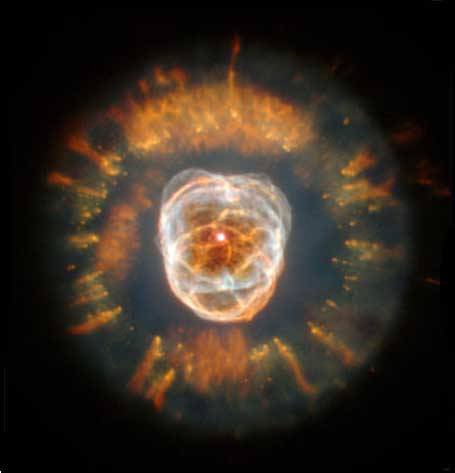
NGC 2392, the Eskimo Nebula.
The Eskimo Nebula (NGC 2392), also known as the Clownface Nebula,[4] is a bipolar[2] double-shell[5] planetary nebula (PN). It was discovered by astronomer William Herschel in 1787. From the ground, it resembles a person's head surrounded by a parka hood. In 2000, the Hubble Space Telescope produced an image of it. From space, the nebula displays gas clouds so complex that they are not fully understood.
Observation data
(Epoch J2000)
Right ascension 07h 29m 10.7669s[1]
Declination +20° 54′ 42.488″[1]
Distance ≥2.9 kly (≥880 pc)[2]
Apparent magnitude (V) 10.1[1]
Apparent dimensions (V) 48″ × 48″[3]
Constellation Gemini
Physical characteristics
Radius ≥0.34 ly[a]
Absolute magnitude (V) ≤0.4 [b]
Notable features –
Other designations NGC 2392,[1] Clown Nebula,[1]
Clown Face[1]
Its inner shell measures 18″ × 15″ and is bright and elliptical and marked on its south rim by two blister-like protrusions. Its outer shell is nearly circular measuring 24″ radius and contains a set of complex low-ionization features. It is observed to have high-dispersion spectra of optical nebular lines which indicate a fast collimated outflow with a velocity along our line of sight of nearly 200 km/s producing dynamic interaction with nebular material. As of 2003, it is estimated to be only ≥1060 years old. The earth's perspective is almost along its axis of symmetry. Its knots have a highly developed symmetry along a radius vector from the PN's central star, except their tails are somewhat irregular. The tails are well developed and frequently of a discernible optical thickness in the visual spectrum. The knots are bright rimmed and have low ionization (as compared to those found in NGC 7293) which indicates their location being inside the ionized zone yet close to the boundary. The knots' heads have local photoionization fronts which appear as bright cusps. At the cusps, the knots become optically thick to Lyc photons from the central star.
It is surrounded by gas that composed the outer layers of a Sun-like star. The visible inner filaments are ejected by strong wind of particles from the central star. The outer disk contains unusual light-year long orange filaments.
NGC 2392 lies about 3000 light-years away and is visible with a small telescope in the constellation of Gemini.
Historic data
Discovered January 17, 1787 by William F. Herschel at Slough England describing it "A star 9th magnitude with a pretty bright middle, nebulosity equally dispersed all around. A very remarkable phenomenon."[6] NGC 2392 WH IV-45 is included in the Astronomical League (U.S.A) Herschel 400 observing program.
Eskimo Nebula Sheds Light On Sun's Eventual Demise
See also
* List of planetary nebulae
* New General Catalogue
Notes
1. ^ Radius = distance × sin(angular size / 2) = ≥2.9 kly * sin(48″ / 2) = ≥0.34 ly
2. ^ 10.1 apparent magnitude - 5 * (log10(≥880 pc distance) - 1) = ≤0.4 absolute magnitude
References
1. ^ a b c d e f SIMBAD Astronomical Database. Results for Eskimo Nebula. Retrieved on 2006-12-22.
2. ^ a b O'dell, C. R.; Balick, B.; Hajian, A. R.; Henney, W. J.; Burkert, A. (2003). "Knots in Planetary Nebulae". Winds, Bubbles, and Explosions: a conference to honor John Dyson, Pátzcuaro, Michoacán, México, September 9-13, 2002 (Eds. S. J. Arthur & W. J. Henney) Revista Mexicana de Astronomía y Astrofísica (Serie de Conferencias) (http://www.astroscu.unam.mx/~rmaa/) 15: 29-33.
3. ^ O'Dell, C. R.; Balick, B.; Hajian, A. R.; Henney, W. J.; Burkert, A. (2002). "Knots in Nearby Planetary Nebulae". The Astronomical Journal 123 (6): 3329-3347.
4. ^ Windows to the Universe
5. ^ Guerrero, M. A.; Chu, Y.-H.; Gruendl, R. A.; Meixner, M. (2005). "XMM-Newton detection of hot gas in the Eskimo Nebula: Shocked stellar wind or collimated outflows?". Astronomy and Astrophysics 430: L69-L72.
6. ^ Historic ref: The Scientific Papers of Sir William Herschel by J. L. E. Dreyer, Royal Society, London 1912
Retrieved from "http://en.wikipedia.org/"
All text is available under the terms of the GNU Free Documentation License

